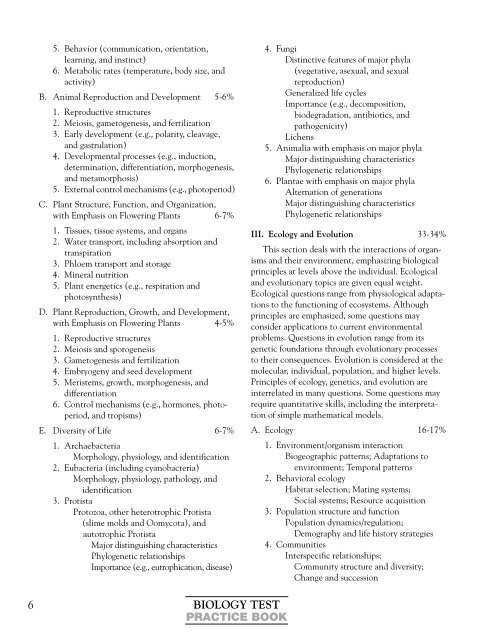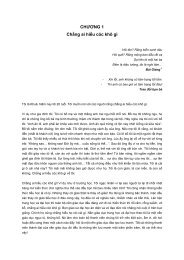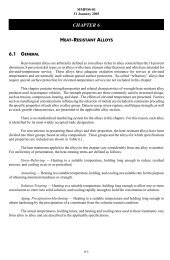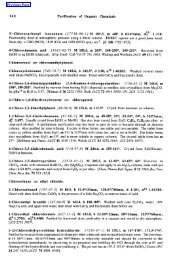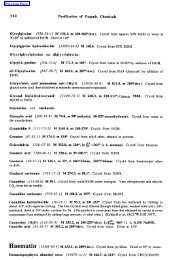BIOLOGY TEST - LavaMind
BIOLOGY TEST - LavaMind
BIOLOGY TEST - LavaMind
You also want an ePaper? Increase the reach of your titles
YUMPU automatically turns print PDFs into web optimized ePapers that Google loves.
5. Behavior (communication, orientation,<br />
learning, and instinct)<br />
6. Metabolic rates (temperature, body size, and<br />
activity)<br />
B. Animal Reproduction and Development 5-6%<br />
1. Reproductive structures<br />
2. Meiosis, gametogenesis, and fertilization<br />
3. Early development (e.g., polarity, cleavage,<br />
and gastrulation)<br />
4. Developmental processes (e.g., induction,<br />
determination, differentiation, morphogenesis,<br />
and metamorphosis)<br />
5. External control mechanisms (e.g., photoperiod)<br />
C. Plant Structure, Function, and Organization,<br />
with Emphasis on Flowering Plants 6-7%<br />
1. Tissues, tissue systems, and organs<br />
2. Water transport, including absorption and<br />
transpiration<br />
3. Phloem transport and storage<br />
4. Mineral nutrition<br />
5. Plant energetics (e.g., respiration and<br />
photosynthesis)<br />
D. Plant Reproduction, Growth, and Development,<br />
with Emphasis on Flowering Plants 4-5%<br />
1. Reproductive structures<br />
2. Meiosis and sporogenesis<br />
3. Gametogenesis and fertilization<br />
4. Embryogeny and seed development<br />
5. Meristems, growth, morphogenesis, and<br />
differentiation<br />
6. Control mechanisms (e.g., hormones, photoperiod,<br />
and tropisms)<br />
E. Diversity of Life 6-7%<br />
1. Archaebacteria<br />
Morphology, physiology, and identification<br />
2. Eubacteria (including cyanobacteria)<br />
Morphology, physiology, pathology, and<br />
identification<br />
3. Protista<br />
Protozoa, other heterotrophic Protista<br />
(slime molds and Oomycota), and<br />
autotrophic Protista<br />
Major distinguishing characteristics<br />
Phylogenetic relationships<br />
Importance (e.g., eutrophication, disease)<br />
4. Fungi<br />
Distinctive features of major phyla<br />
(vegetative, asexual, and sexual<br />
reproduction)<br />
Generalized life cycles<br />
Importance (e.g., decomposition,<br />
biodegradation, antibiotics, and<br />
pathogenicity)<br />
Lichens<br />
5. Animalia with emphasis on major phyla<br />
Major distinguishing characteristics<br />
Phylogenetic relationships<br />
6. Plantae with emphasis on major phyla<br />
Alternation of generations<br />
Major distinguishing characteristics<br />
Phylogenetic relationships<br />
III. Ecology and Evolution 33-34%<br />
This section deals with the interactions of organisms<br />
and their environment, emphasizing biological<br />
principles at levels above the individual. Ecological<br />
and evolutionary topics are given equal weight.<br />
Ecological questions range from physiological adaptations<br />
to the functioning of ecosystems. Although<br />
principles are emphasized, some questions may<br />
consider applications to current environmental<br />
problems. Questions in evolution range from its<br />
genetic foundations through evolutionary processes<br />
to their consequences. Evolution is considered at the<br />
molecular, individual, population, and higher levels.<br />
Principles of ecology, genetics, and evolution are<br />
interrelated in many questions. Some questions may<br />
require quantitative skills, including the interpretation<br />
of simple mathematical models.<br />
A. Ecology 16-17%<br />
1. Environment/organism interaction<br />
Biogeographic patterns; Adaptations to<br />
environment; Temporal patterns<br />
2. Behavioral ecology<br />
Habitat selection; Mating systems;<br />
Social systems; Resource acquisition<br />
3. Population structure and function<br />
Population dynamics/regulation;<br />
Demography and life history strategies<br />
4. Communities<br />
Interspecific relationships;<br />
Community structure and diversity;<br />
Change and succession<br />
6 <strong>BIOLOGY</strong> <strong>TEST</strong><br />
PRACTICE BOOK


